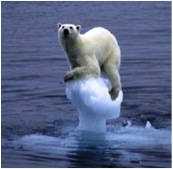 While public policy on climate change continues to be debated in local and national governments, the effects of global warming are already being felt by many different plant and animal populations. Rising temperatures can directly impact plant and animal populations by causing range shifts as species are forced to move into areas with temperatures they can tolerate. In the process of shifting home ranges different species that were previously isolated from one another may come in contact, leading to new biotic interactions (whether they be predator-prey, host-parasite, or resource competitor interactions).
While public policy on climate change continues to be debated in local and national governments, the effects of global warming are already being felt by many different plant and animal populations. Rising temperatures can directly impact plant and animal populations by causing range shifts as species are forced to move into areas with temperatures they can tolerate. In the process of shifting home ranges different species that were previously isolated from one another may come in contact, leading to new biotic interactions (whether they be predator-prey, host-parasite, or resource competitor interactions).
In this lesson, students will be introduced to the basics of climate change research. Specifically, focusing on the impact climate change will have on the plant and animal populations. We will investigate a number of specific aspects that will be directly impacted through climatic changes, with a number of real world examples. The lesson is broke into three main portions, a brief introductory presentation, an interactive, outdoor game, and a worksheet developed to engage students with real scientific graphs and data.
At the conclusion of the lesson, students will be able to:
- Link human actions with changes taking place on Earth
- Explain how rising temperatures are influencing animal/plant populations
- Describe specific examples where climate change may be either detrimental or beneficial
- Gain experience interpreting graphs and making conclusions
- Get excited about role-playing as an animal
Resources:
- Hot in Here powerpoint
- Hot in Here lesson plan
- Hot in Here rule sheet
- Hot in Here worksheet
Lesson plan written and created by GK-12 Fellows Jake Nalley and Michael Kuczynski, 2012
